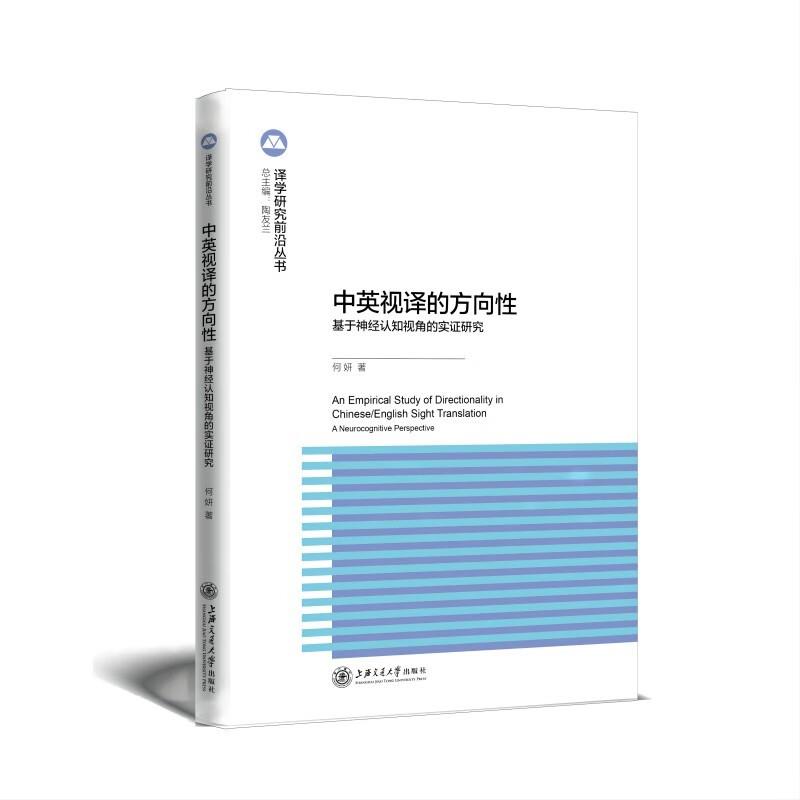
中英视译中的方向性:基于神经认知视角的实证研究:a neurocogntive perspective
1星价
¥56.2
(7.2折)
2星价¥56.2
定价¥78.0

暂无评论
图文详情
- ISBN:9787313272812
- 装帧:一般胶版纸
- 册数:暂无
- 重量:暂无
- 开本:24cm
- 页数:217页
- 出版时间:2022-09-01
- 条形码:9787313272812 ; 978-7-313-27281-2
内容简介
本书从神经认知视角考察口译方向性在口译经验和文本复杂度的作用下对视译认知加工的影响。研究发现口译方向性对认知加工的影响受到口译经验的制约。根据相关脑区数据可以推测:当中译英时,口译学生需要在与认知抑制相关的执行功能上付出更多的认知努力;非口译学生需要在与多任务协调、语言转换、注意力资源分配、任务监控等相关的执行功能上付出更多的认知努力。这一结果也揭示了大量的口译实践可以强化口译员的大脑执行功能。本书可供翻译研究者使用。
目录
Contents
Chapter 1 Introduction ……………………………………………………………1
1.1 Research Background ………………………………………………1
1.2 Research Objectives and Questions ………………………………3
1.3 Research Signif icance and Motivation of the Study ………………4
1.4 Potential Contributions of the Study …………………………………5
1.5 Summary ………………………………………………………………5
Chapter 2 The Phenomenon of Sight Translation ………………………………6
2.1 The Def inition of Sight Translation …………………………………6
2.2 Sight Translation in Practice and Education ………………………8
2.3 Sight Translation and Cognitive Effort ……………………………10
2.4 Summary ……………………………………………………………12
Chapter 3 Situating the Study in the Literature ………………………………13
3.1 Directionality …………………………………………………………13
3.1.1 Arguments on Directionality …………………………………13
3.1.2 Empirical Studies on Directionality …………………………16
3.2 The Cognitive Effort in Translation and Interpreting ……………27
3.2.1 Processing Time Measurement ………………………………27
3.2.2 The Keystroke-Logging Method ……………………………28
3.2.3 The Eye-Tracking Method ……………………………………30
3.2.4 The Cognitive Effort in the “Black Box” ……………………31
3.3 Competence in Translation and Interpreting Studies …………34
3.4 Text Complexity ……………………………………………………38
中英视译的方向性—基于神经认知视角的实证研究(英文版)
3.5 Summary ……………………………………………………………40
Chapter 4 Theoretical Framework ……………………………………………41
4.1 Language Processing in the Bilingual Brain ……………………41
4.1.1 The Three-Store Hypothesis …………………………………41
4.1.2 The Subsystems Hypothesis …………………………………42
4.2 Translation/Interpreting Asymmetry ………………………………44
4.2.1 The Revised Hierarchical Model ……………………………44
4.2.2 The Activation Threshold Hypothesis ………………………45
4.3 The Interpreter Advantage Hypothesis …………………………47
4.4 Text Complexity and Cognitive Effort ……………………………48
4.5 Theoretical Assumptions …………………………………………49
4.6 Summary ……………………………………………………………50
Chapter 5 The Neuroimaging Technology ……………………………………51
5.1 The Development of Neuroimaging Technology ………………51
5.2 Introduction to fNIRS ………………………………………………56
5.3 fNIRS in Language Processing Research ………………………58
5.3.1 Language Comprehension ……………………………………59
5.3.2 Overt Reading ………………………………………………60
5.3.3 Speech Production ……………………………………………61
5.4 Using fNIRS in the Present Study…………………………………62
5.5 Summary ……………………………………………………………63
Chapter 6 A Pilot Study …………………………………………………………64
6.1 Participants …………………………………………………………64
6.2 Materials ……………………………………………………………65
6.3 Tasks …………………………………………………………………66
6.4 Data Acquisition ……………………………………………………66
6.5 Data Analysis ………………………………………………………67
6.6 Results ………………………………………………………………68
6.7 Discussion …………………………………………………………69
Chapter 7 Methods………………………………………………………………72
7.1 Research Design ……………………………………………………72
7.2 Participants …………………………………………………………73
7.2.1 Participant Recruitment ………………………………………73
7.2.2 Second Language Prof iciency Test …………………………74
7.2.3 Pre-experiment Survey ………………………………………76
7.2.4 Working Memory Span Test …………………………………76
7.2.5 The Selected Participants ……………………………………77
7.2.6 Ethical Issues …………………………………………………80
7.3 Materials ……………………………………………………………81
7.3.1 Grade Level …………………………………………………82
7.3.2 Sentence Structure ……………………………………………83
7.3.3 Word Count …………………………………………………83
7.3.4 Word Frequency ………………………………………………86
7.3.5 Notional Word Density ………………………………………88
7.3.6 Pronoun Density ……………………………………………89
7.3.7 Translatability ………………………………………………90
7.3.8 The Distinction Between Sentences of Low and High
Complexity ……………………………………………………91
7.4 Brain Areas of Interest ……………………………………………94
7.4.1 Dorsolateral Prefrontal Cortex ………………………………95
7.4.2 Broca's Area …………………………………………………97
7.4.3 Wernicke's Area ………………………………………………98
7.4.4 Inferior Parietal Lobule ………………………………………100
7.5 Experiment Procedure ……………………………………………101
7.6 Data Collection………………………………………………………103
7.6.1 Behavioural Data Collection …………………………………103
7.6.2 fNIRS Data Collection ………………………………………104
7.7 Data Preprocessing…………………………………………………106
7.7.1 Behavioural Data Preprocessing ……………………………108
7.7.2 fNIRS Data Preprocessing ……………………………………108
7.8 Data Analysis ………………………………………………………109
7.8.1 The Statistical Terms in the Present Study ……………………109
7.8.2 Behavioural Data Analysis ……………………………………111
中英视译的方向性—基于神经认知视角的实证研究(英文版)
7.8.3 fNIRS Data Analysis …………………………………………112
7.9 Summary ……………………………………………………………113
Chapter 8 Results ………………………………………………………………114
8.1 Behavioural Results ………………………………………………114
8.1.1 The Main Effect ………………………………………………114
8.1.2 The Interaction Effect ………………………………………117
8.2 Neuroimaging Results ……………………………………………120
8.2.1 The Main Effect ………………………………………………121
8.2.2 The Interaction Effect ………………………………………128
8.3 Results from the Post-experiment Survey ………………………140
8.4 Summary ……………………………………………………………140
Chapter 9 Discussion ……………………………………………………………144
9.1 Directionality and Behavioural Performance ……………………144
9.2 Directionality and Cognitive Effort …………………………………148
9.3 Directionality, Interpreting Experience and Text Complexity …151
9.4 Summary ……………………………………………………………155
Chapter 10 Conclusion …………………………………………………………157
10.1 Final Conclusions …………………………………………………157
10.2 Implications ………………………………………………………159
10.2.1 Theoretical Implication ……………………………………159
10.2.2 Methodological Implication ………………………………160
10.2.3 Pedagogical and Practical Implication ……………………161
10.3 Limitations and Perspective for Future Work …………………162
10.4 Summary …………………………………………………………163
References …………………………………………………………………………164
Appendices …………………………………………………………………………185
Appendix 1 English Prof iciency Test …………………………………185
Appendix 2 Personal and Language Background
Questionnaire ………………………………………………193
Appendix 3 Reading Span Test ………………………………………195
Appendix 4 Informed Content …………………………………………198
Appendix 5 Chinese and English Texts Used in the
Experiment …………………………………………………201
Appendix 6 Post-experiment Survey …………………………………204
Appendix 7 The 3D MNI Coordinates of the 68 Channels and
the Corresponding Brain Area ……………………………205
Index ………………………………………………………………………………214
展开全部
本类五星书
本类畅销
-

地心游记(纯英文)/床头灯英语.3000词读物
¥5.4¥15.8 -

茶花女
¥4.2¥12.0 -

流浪地球刘慈欣
¥21.1¥62.0 -

小妇人(纯英文)/床头灯英语.3000词读物
¥4.7¥15.8 -

了不起的盖茨比(纯英文)/床头灯英语.3000词读物
¥4.5¥12.8 -

本杰明:富兰克林自传
¥4.7¥13.5 -

THE GREAT GATSBY-了不起的盖茨比
¥6.9¥16.8 -

Sons and Lovers
¥7.8¥26.0 -

方法论
¥3.9¥9.5 -

写给儿童看的英语:情境联想600句(英汉对照)
¥17.1¥39.8 -

最新英汉百科图解词典-升级版
¥104.2¥168.0 -

命案目睹记
¥21.7¥33.8 -

沉思录
¥10.5¥21.0 -

巴黎圣母院
¥4.7¥15.5 -

英诗选译-孙大雨译文集-(英汉对照)
¥12.2¥36.0 -

莎士比亚四大悲剧(世界文学名著英文版)
¥12.2¥32.0 -

城堡
¥13.0¥26.0 -

查拉图斯特拉加是说
¥14.5¥29.0 -

飞鸟集(泰戈尔英汉双语诗集)
¥9.5¥11.9 -

无英语词根与单词的说文解字(新版)(2020)
¥52.7¥65.9











